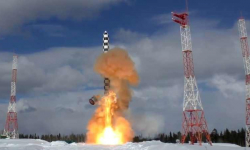The launch of the Sarmat rocket with 100 percent "stuffing" from Russian electronic components made the West think where their sanctions will lead....

The first thing that comes to mind when the words "domestic nodes, components, parts" are microprocessors called "chips." This term, when it appeared, meant a crystal plate or film, which is a micro-device placed in an indiscriminate case, according to The Moscow Post.
Recall that twenty years ago, mobile phones were at the disposal of 1.4 million Russians. By the beginning of 2022, the total number of subscribers of cellular operators reached 227 million, one and a half times higher than the population. And although the Russian smartphone manufactured by Rostec - AYYA T1 appeared on sale recently and its manufacturers still have a lot to do to compete with foreigners, the main thing is different.
Namely, the fact that some "foreigners" cannot compete with "Sarmat" and other systems of Russian weapons. This means that Russian and Belarusian enterprises of the semiconductor and radio-electronic industry will modernize and grow in predictable conditions, with government orders and guaranteed demand from Russian consumers, especially industrial enterprises. This should help the civilian sector of the semiconductor industry.
Swimming "Baikal" and climbing "Elbrus"Now semiconductors and microcircuits created on their basis - chips are the most important elements of any electronic device. The manufacture of modern-level chips is a complex and costly process. No state is able to completely localize the production of the full cycle and the entire range of products.
The United States, the European Union and Japan announced that they would limit Russia's access to advanced technologies. The sanctions will affect the export of semiconductors, telecommunications equipment, electronic components. The European Union has developed the fifth package of sanctions, which has a ban on high-purity silicon. It is forbidden to supply equipment for photolithography and other processes used in the production of microcircuits.
Under the conditions of sanctions, the production of Elbrus and Baikal processors may have to be transferred from TSMC enterprises in Taiwan to China, which will take time, Oleg Emeramrudov, executive director of the RosSHD Storage Systems Developers Consortium, said in an interview with Gazeta.Ru.
Recall that TSMC (Taiwan Semiconductor Manufacturing Company) announced the cessation of production of Russian processors, but thinking decided that Russia could "turn off" their production with retaliatory sanctions. For example, sapphire substrates, ultra-pure chemistry, rare earth elements are supplied from Russia. Without them, chip production will rise.
Russia's share in the production of artificial sapphires is about 40%, in the market of substrates for microcircuits - 70-80%. The Ministry of Industry and Trade admits stopping the export of artificial sapphires, but only as a last resort. The largest producer in Russia and the world is the Monocrystal plant, which grows artificial sapphires and makes them sapphire substrates used for the production of light-emitting diode (LED).
Sapphires are made of glass for the screens of some mobile phones and watches, including the smart Apple Watch. The plant exports almost all of its products and is the world's largest sapphire producer. According to experts, artificial sapphires produced by foreign companies are usually more expensive and of worse quality. In addition to the domestic "Single Crystal," sapphires are produced by the Chinese company Aurora, two Japanese - Namiki Precision Jewel Co. and Kyocera, and the American - Rubicon.
Nano manoOleg Emeraludov predicts the prospects for the development of the industry: "Silicon technologies have already reached their limit. This limit is one nanometer. The only way to increase power is to increase the number of transistors and we need to go into volumetric structures. Silicon technology does not allow this due to the peculiarities of the material, and gallium arsenide allows. " Gallium will allow the production of volumetric microcircuits.
The government cannot take risks. The economy, industry, the course towards digitalization require reliance on proven and reliable solutions. A new national project has been developed covering the field of electronics, aimed at developing the industry. According to Kommersant, a preliminary version of the document is ready and it is known that the authorities are going to spend trillions of rubles on its implementation until 2030. The developer is the Ministry of Industry and Trade, 22 working groups took part in the preparation. The document will be sent for consideration to the Prime Minister on April 22.
Finance should be distributed in four areas, including infrastructure development, production of domestic products, increased demand for it, as well as personnel. By the end of this year, it is planned to launch a program for reengineering foreign solutions in the field of electronics, transferring their production to Russia.
We are talking about launching the production of microcircuits using a 90nm (nm) process technology. Intel reached this level twenty years ago. In the Russian Federation, there is a production of microcircuits with design standards of 90 nm, there are developments for 65 nm. This is the level of processors of 2005-2008, but it is enough for household appliances, cars, power plants, industrial equipment, as well as for solving most applied issues. For 2030, the norms of 28 nm, mastered ten years ago, are planned. Intel factories produce 10nm chips, Samsung and TSMC are moving to 5nm chips from 2020.
By 2024, it is planned to launch a program for the development of electronic engineering, to provide "100% import substitution in all areas," by 2030 - to complete the formation of a "product portfolio of Russian technologies."
Frames decide, but not all yetPersonnel shortage is one of the problems of the electronic industry. The government expects an order to increase the number of specialists involved in the production and design of radio electronics, to increase their number by 2030 to 9 thousand per year. Now universities of the Russian Federation graduate annually about 20 thousand specialized specialists, but only 5% of this number work by profession. According to the Kommersant publication, it was proposed to organize "end-to-end training and personnel management" from schools to universities and workplaces, launch joint laboratories with enterprises, increase targeted recruitment for specialized departments, involve students in R&D, and stimulate this process by creating at least 25 youth laboratories annually.
The plans include grant support for projects and project teams formed on the basis of universities and small companies. This will allow by 2030 to additionally train and retain about 60 thousand young specialists in the industry, providing Russian enterprises with personnel. In total, about 300 thousand people work in the industry. It is planned to allocate more than 300 billion rubles for the federal project "Training personnel and scientific foundation for the electronic industrial. from the budget.
The "Rich" Cry TooIf we talk about the United States, then their handkerchief has long been wet from tears. It hurts Washington to feel its vulnerability in chips, especially in the field of providing military equipment with chips. Back in 2012, the Congressional Armed Services Committee completed an investigation that found there were counterfeit components in weapons systems. Fake parts counted more than a million.
Fakes could come from China, Canada and the UK. Such chips were found in computers, helicopter equipment, aircraft and submarines. Counterfeits could also be installed in missile defense systems control systems. Counterfeit products were found in equipment purchased from weapons manufacturers who purchased equipment from subcontractors.
A year ago, the US Department of Defense signed a contract with GlobalFoundries for the supply of chips for the needs of the army, produced using a 45-nm process technology. GlobalFoundries is an important part of the U.S. semiconductor industry, which is essential for national security, as a key chip supplier to our military and intelligence, said Sen. Chuck Schumer, who proposed the "CHIPS for America" program.
Taiwanese "chipping" as a diagnosisAccording to the Semiconductor Industry Association (SIA), the U.S. share of chip manufacturing has declined from 37% in 1990 to 12% today. According to SIA, in the absence of significant actions, this share may soon fall to 10%. Reviving chip production will take decades, according to experts at Harvard Business School. So far, the authorities are limited to subsidies.
In February last year, Biden signed an order obliging the relevant departments to determine steps to eliminate the vulnerability. And just over a year ago, the then newly elected president met with the heads of leading manufacturers, including TSMC, Samsung, Intel, Medtronic and Micron. They were joined by executives from Google, Dell, HP and AT&T Communications, as well as automakers General Motors and Ford Motor, which have been hit hard by chip shortages.
Import substitution in this area is likely to become a long-term program for the United States. Last June, the US Department of Commerce published a report aimed at restoring the industrial base and developing innovation in the United States (Building Resilient Supply Chains, Revitalizing American Manufacturing, And Fostering Broad-Based Growth). In the section of the report on semiconductors, it was noted that the transfer of power outside the United States led to the fact that the links responsible for R&D also moved closer to the production base.
According to the Nikkei Asian Review, the 250-page report mentions Taiwan 80 times and China more than 500 times. It was noted that the market approaches prevailing in the United States were unable to stimulate qualitative shifts in industry. From 2009 to 2018, S & P500 companies distributed 91% of net income in the form of share payments or dividends. The focus on short-term returns has led to lower R&D spending. Semiconductors were among such "underinvested" industries.
In addition, specialized American chipmakers preferred fabless projects, that is, without the foundry of silicon wafers. Industry leaders including AMD, Broadcom, NVIDIA, Qualcomm and Xilinx have outsourced their developments to businesses based in China, South Korea or Taiwan. This achieved savings in the construction of capital-intensive enterprises.
The factories of the Taiwanese TSMC are built according to the integrated device manufacturers (IDM) scheme. Such plants themselves may not develop their own chips and work on orders from fabless firms. But Samsung and TSMC provide foundry services, producing their own chips. IDM accounts for about 70% of the world's capacity, located mainly in Asia and Taiwan.
The island's authorities, which account for more than 92% of the production of recent generations of semiconductors, subsidize new projects, covering about 50% of the cost of acquiring plots of land and up to 45% of the cost of construction and infrastructure. Subsidies provided by the authorities of South Korea and Singapore reduce the cost of projects for investors by 25-30%.
Taiwan is second only to the United States in terms of revenue from semiconductor sales, and TSMC controls 56% of the contract production market. Taiwan is considered Washington's political partner, but the geography of the island, coupled with the fact that China considers it its province, unnerves the United States. In White House estimates, dependence on Taiwan for semiconductor supplies is fraught with big risks.
The concern of the US authorities is not only the geopolitical situation around Taiwan, but also the island's exposure to various kinds of natural disasters and adverse natural factors such as drought, which last year led to a shortage of running water, has made producers difficult.
Other countries are mentioned in the report. South Korea controls the bulk of the memory chip market. Japanese manufacturers are 90% dependent on the supply of silicon wafer chemicals and the supply of wafers themselves. Global chip shortages are combined with reliance on foundries concentrated in Asia.
After Biden's order, issued in February 2021, the United States negotiated with Taiwan. In May 2021, TSMC announced its intention to build a $12 billion chip plant in Arizona. Intel also announced plans to build two plants worth about $20 billion, also in Arizona. Intel's total investment should be $20 billion.
America, which has imposed sanctions on Russia, is also inclined to localize production, which will require many tens of billions of dollars, and maybe hundreds, for many years. The question is, where will they buy sapphire substrates?
Читать на "The Moscow Post"
